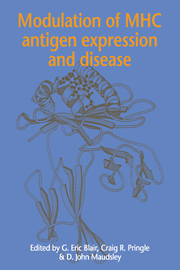Book contents
- Frontmatter
- Contents
- List of contributors
- Preface
- List of abbreviations
- 1 General introduction to the MHC
- 2 Organization of the MHC
- 3 Interactions of cytokines in the regulation of MHC class I and class II antigen expression
- 4 Control of MHC class I gene expression
- 5 Control of MHC class II gene expression
- 6 Modulation of MHC antigen expression by viruses
- 7 Modulation of MHC antigen expression by retroviruses
- 8 Modulation of MHC class I antigen expression in adenovirus infection and transformation
- 9 MHC expression in HPV-associated cervical cancer
- 10 Inhibition of the cellular response to interferon by hepatitis B virus polymerase
- 11 Cellular adhesion molecules and MHC antigens in cells infected with Epstein-Barr virus: implications for immune recognition
- 12 Effect of human cytomegalovirus infection on the expression of MHC class I antigens and adhesion molecules: potential role in immune evasion and immunopathology
- 13 Oncogenes and MHC class I expression
- 14 Mechanisms of tumour cell killing and the role of MHC antigens in experimental model systems
- 15 Manipulation of MHC antigens by gene transfection and cytokine stimulation: a possible approach for pre-selection of suitable patients for cytokine therapy
- 16 Overexpression of MHC proteins in pancreatic islets: a link between cytokines, viruses, the breach of tolerance and insulindependent diabetes mellitus?
- 17 The role of cytokines in contributing to MHC antigen expression in rheumatoid arthritis
- 18 Expression of an MHC antigen in the central nervous system: an animal model for demyelinating diseases
- Index
17 - The role of cytokines in contributing to MHC antigen expression in rheumatoid arthritis
Published online by Cambridge University Press: 11 September 2009
- Frontmatter
- Contents
- List of contributors
- Preface
- List of abbreviations
- 1 General introduction to the MHC
- 2 Organization of the MHC
- 3 Interactions of cytokines in the regulation of MHC class I and class II antigen expression
- 4 Control of MHC class I gene expression
- 5 Control of MHC class II gene expression
- 6 Modulation of MHC antigen expression by viruses
- 7 Modulation of MHC antigen expression by retroviruses
- 8 Modulation of MHC class I antigen expression in adenovirus infection and transformation
- 9 MHC expression in HPV-associated cervical cancer
- 10 Inhibition of the cellular response to interferon by hepatitis B virus polymerase
- 11 Cellular adhesion molecules and MHC antigens in cells infected with Epstein-Barr virus: implications for immune recognition
- 12 Effect of human cytomegalovirus infection on the expression of MHC class I antigens and adhesion molecules: potential role in immune evasion and immunopathology
- 13 Oncogenes and MHC class I expression
- 14 Mechanisms of tumour cell killing and the role of MHC antigens in experimental model systems
- 15 Manipulation of MHC antigens by gene transfection and cytokine stimulation: a possible approach for pre-selection of suitable patients for cytokine therapy
- 16 Overexpression of MHC proteins in pancreatic islets: a link between cytokines, viruses, the breach of tolerance and insulindependent diabetes mellitus?
- 17 The role of cytokines in contributing to MHC antigen expression in rheumatoid arthritis
- 18 Expression of an MHC antigen in the central nervous system: an animal model for demyelinating diseases
- Index
Summary
Introduction
Rheumatoid arthritis (RA) is a chronic inflammatory disease with autoimmune features chiefly affecting the synovial joints. In common with many other autoimmune diseases, there is emerging evidence to suggest that susceptibility to RA is determined by several genes (Wordsworth & Bell, 1991). However, despite the evidence of a genetic predisposition (in particular HLA-DR4 or HLA-DR1), it is clear that the genetic component is probably relatively small since concordance rates in monozygotic twins are no more than 30%, suggesting that other factors are involved (Wordsworth & Bell, 1991; Rigby et al., 1991; Silman, 1991).
The target tissue for the autoimmune and inflammatory response in RA is the synovial joint. In healthy individuals, the synovial membrane is virtually acellular, but in RA it is infiltrated extensively by large numbers of cells from the blood, including activated T cells, macrophages and plasma cells (Janossy et al., 1981; Fϕrre, Dobloug & Natvig, 1982; Burmester et al., 1982). In addition, there is proliferation of fibroblasts in the lining layer of the synovial membrane. Many of these infiltrating and resident cells including endothelial cells, fibroblasts and T cells normally express little, if any, HLA class II antigens but are activated in the RA synovium and express abundant HLA class II antigens (Førre et al., 1982; Klareskog et al., 1982; Burmester et al., 1987). These cells may act as antigen-presenting cells and be involved in the stimulation of autoreactive T cells.
- Type
- Chapter
- Information
- Modulation of MHC Antigen Expression and Disease , pp. 390 - 408Publisher: Cambridge University PressPrint publication year: 1995



